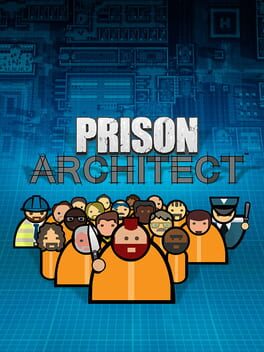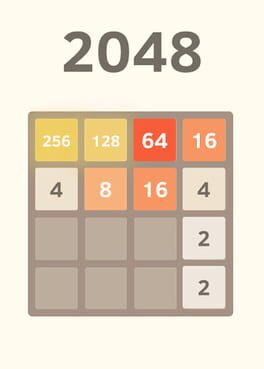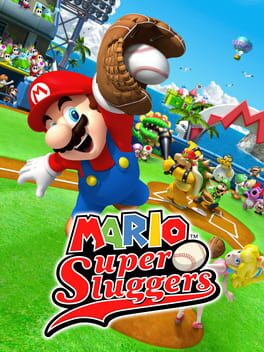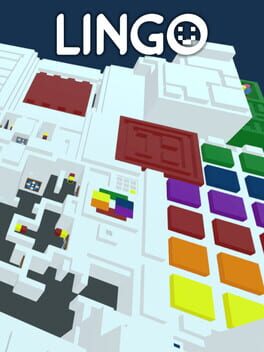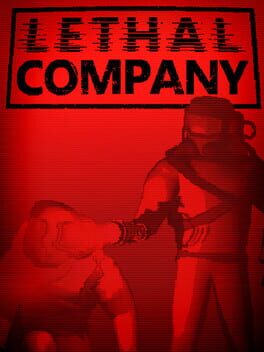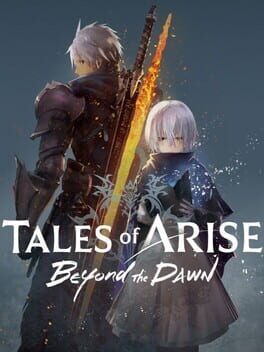Gana
2018
It very successfully pulls off the "survival horror game in the guise of an RPG" thing. Like other reviews have said, I'm sure if I read a walkthrough for long enough I'd get a better understanding of this game's mechanics, the ways you can actually start surviving, etc. I did some of that at the start, in terms of learning that apparently in order to have a fighting chance in this game there's a hidden requirement to pick the starting choices that give you the dash skill. There's more things that can just be learned from trial and error (and/or a walkthrough), like what parts of each map aren't randomly generated and what things you should pick up every playthrough, what parts of each enemy are the best to attack, when in combat you should guard, when talking to an enemy will actually give you something, etc. But figuring all those things out manually takes a lot of time, and learning them from a walkthrough wrecks the game's atmosphere. Eventually I would probably start having fun.
I'm going to make an unusual comparison to the weird, artistic PS2 game Chulip. In Chulip, you take damage from doing just about anything, save points are unrefined, and trying to figure out what to do requires a lot of intuition (aka a good internet connection), time, and patience, as Chulip's save points are only a little bit more forgiving than this game's. Chulip is trying to make the point that in order to see the world, you have to be willing to be hurt. Chulip overdoes it in this matter, because it's very likely that rather than be hurt now and then you'll just get oneshot by something you can't even predict happening. This has the effect of making the game feel like pulling teeth, making any action with an unpredictable result feel like a bad gamble, that it'd be safer to engage with as little of the game as possible.
Where I'm going with that little tangent is that F&H's unforgiving nature makes it similarly difficult to actually want to interact with the game. Sure, I could spend time poking around every corner, clicking every option for Talk, trying to see every result of every choice I make. But when the overwhelming likelihood is that I'm just gonna die, or lose my limbs, and lose my progress all over again, why should I? It feels like punching every brick in a wall until I find the one that opens up a secret door.
Still, it's good horror. I like the game's art a lot, and when you aren't hung up on the end and are more focused on the journey itself, it can be fun to play. Recommended to anyone who likes survival horror and doesn't mind a game that wants you to figure out a lot of things yourself.
I'm going to make an unusual comparison to the weird, artistic PS2 game Chulip. In Chulip, you take damage from doing just about anything, save points are unrefined, and trying to figure out what to do requires a lot of intuition (aka a good internet connection), time, and patience, as Chulip's save points are only a little bit more forgiving than this game's. Chulip is trying to make the point that in order to see the world, you have to be willing to be hurt. Chulip overdoes it in this matter, because it's very likely that rather than be hurt now and then you'll just get oneshot by something you can't even predict happening. This has the effect of making the game feel like pulling teeth, making any action with an unpredictable result feel like a bad gamble, that it'd be safer to engage with as little of the game as possible.
Where I'm going with that little tangent is that F&H's unforgiving nature makes it similarly difficult to actually want to interact with the game. Sure, I could spend time poking around every corner, clicking every option for Talk, trying to see every result of every choice I make. But when the overwhelming likelihood is that I'm just gonna die, or lose my limbs, and lose my progress all over again, why should I? It feels like punching every brick in a wall until I find the one that opens up a secret door.
Still, it's good horror. I like the game's art a lot, and when you aren't hung up on the end and are more focused on the journey itself, it can be fun to play. Recommended to anyone who likes survival horror and doesn't mind a game that wants you to figure out a lot of things yourself.
This review contains spoilers
Excellent game. The elephant in the room is, of course, that calling it a Remake is a boldfaced lie. Certain people (massive fucking cowards whose taste I will never trust) hate this. They wanted a faithful remake, or they just hate Nomura, and while it's somewhat unfortunate that they still don't have anything resembling that to this day, I think what we got instead is way better. (And it's not like the original FF7 is hard to play, anyways.) This game is very distinctly a spinoff in the guise of a remake. As far as I know, the concept of a reimagining in the disguise of a remake was and still is a revolutionary concept in this industry. For that alone, I respect the hell out of Nomura and his plan. What's better is just how well it turned out.
I'll be the first to admit that this game has incredibly cheesy dialogue, stuff that had me legitimately cringing in the early game. But as far as characterization goes, I think this game has some of the best I've ever seen. Cloud is a really good example; how on earth do you convincingly portray someone as both incredibly cool and hilariously awkward at the same time? This game walks that line perfectly from start to finish. The only part of the game I can think of him being out of character was him being actually good at dancing during the Honey Bee Inn segment, and the rest of that scene is so good that I don't even care. The other characters got similarly excellent treatment; I don't think anyone in the cast got robbed, and I left this game feeling way more positively about certain characters than I did after playing the original.
Another big aspect of the writing that I loved was Shinra. The original game's plot about a violent terrorist organization blowing up reactors to save the environment is already extremely impactful to modern audiences, and this game was right on target with its portrayal of Avalanche, Shinra, and Midgar as a whole. To put it frankly, I don't think a game has made me think of Post-9/11 America specifically as much as this game has. The platefall chapter has Shinra troops crying out "We don't negotiate with terrorists". The same chapter has one of the rebels call them fascists, and I respect the hell out of the writers for actually using that word. You break into Shinra HQ and get a cheery tour video telling you a propagandized-version of Shinra's plan to take the promised land. Shinra and Midgar citizens alike accuse the terrorist organization of being backed by old, foreign enemies. It's not Disco Elysium levels of political allegory, but in general politics make up a very large portion of this game's pot and they're handled extremely well.
Now I'll address the Whispers. I actually guessed what the whispers represented well before it was confirmed in the endgame, which I think is a sign that the "twist" was done fairly well. I think these are raw as hell. Having a force in the game representing the will of the original story is such a cool way to do the classic Fighting Fate plot. Miraculously, the stuff going on with Wedge with them towards the end actually got me to enjoy his character, with the line "Just tell me that I made a difference" probably being my favorite line in the game for how well it combines the meta-themes and the general theme of uselessness that his character had in this game. Genius writing decision to have him be the one who survives the collapse, honestly. Wedge haters are all illiterate.
Let's move on to the gameplay. I don't love the ATB system. I think making normal attacks until you're allowed to do something interesting is, while technically action combat, very much still in the spirit of turn-based combat in that it's basically waiting until you can do something interesting. It is somewhat redeemed in that certain behaviors (or the use of certain materia) can accelerate your ATB gain, which incentivizes you to keep the pressure on the enemies, but in general I think the concept of ATB itself is weak, which is unfortunate because the entire combat system is built around it. What redeems this game's combat for me is, similar to the original FF7, the materia system is awesome. I think most materia in the game is reworked such that it works really well with the action combat, making it both fun to use and fun to strategize around.
AAA game design is surprisingly common in this game, and I don't like that. The most common thing is the use of squeeze-throughs, which alone are enough for me to not give this game 5 stars. These always take me out of it, and I inherently reject them because it prevents future versions of the game to have faster load times because you've gone for a hardcoded waiting period instead of an actual load time. Karmically, this was almost immediately made an issue by the existence of the PS5 upgrade.
In summary, I trust Nomura's plan and am very curious to see what Rebirth does going forward. fuck all the haters this is not for them
I'll be the first to admit that this game has incredibly cheesy dialogue, stuff that had me legitimately cringing in the early game. But as far as characterization goes, I think this game has some of the best I've ever seen. Cloud is a really good example; how on earth do you convincingly portray someone as both incredibly cool and hilariously awkward at the same time? This game walks that line perfectly from start to finish. The only part of the game I can think of him being out of character was him being actually good at dancing during the Honey Bee Inn segment, and the rest of that scene is so good that I don't even care. The other characters got similarly excellent treatment; I don't think anyone in the cast got robbed, and I left this game feeling way more positively about certain characters than I did after playing the original.
Another big aspect of the writing that I loved was Shinra. The original game's plot about a violent terrorist organization blowing up reactors to save the environment is already extremely impactful to modern audiences, and this game was right on target with its portrayal of Avalanche, Shinra, and Midgar as a whole. To put it frankly, I don't think a game has made me think of Post-9/11 America specifically as much as this game has. The platefall chapter has Shinra troops crying out "We don't negotiate with terrorists". The same chapter has one of the rebels call them fascists, and I respect the hell out of the writers for actually using that word. You break into Shinra HQ and get a cheery tour video telling you a propagandized-version of Shinra's plan to take the promised land. Shinra and Midgar citizens alike accuse the terrorist organization of being backed by old, foreign enemies. It's not Disco Elysium levels of political allegory, but in general politics make up a very large portion of this game's pot and they're handled extremely well.
Now I'll address the Whispers. I actually guessed what the whispers represented well before it was confirmed in the endgame, which I think is a sign that the "twist" was done fairly well. I think these are raw as hell. Having a force in the game representing the will of the original story is such a cool way to do the classic Fighting Fate plot. Miraculously, the stuff going on with Wedge with them towards the end actually got me to enjoy his character, with the line "Just tell me that I made a difference" probably being my favorite line in the game for how well it combines the meta-themes and the general theme of uselessness that his character had in this game. Genius writing decision to have him be the one who survives the collapse, honestly. Wedge haters are all illiterate.
Let's move on to the gameplay. I don't love the ATB system. I think making normal attacks until you're allowed to do something interesting is, while technically action combat, very much still in the spirit of turn-based combat in that it's basically waiting until you can do something interesting. It is somewhat redeemed in that certain behaviors (or the use of certain materia) can accelerate your ATB gain, which incentivizes you to keep the pressure on the enemies, but in general I think the concept of ATB itself is weak, which is unfortunate because the entire combat system is built around it. What redeems this game's combat for me is, similar to the original FF7, the materia system is awesome. I think most materia in the game is reworked such that it works really well with the action combat, making it both fun to use and fun to strategize around.
AAA game design is surprisingly common in this game, and I don't like that. The most common thing is the use of squeeze-throughs, which alone are enough for me to not give this game 5 stars. These always take me out of it, and I inherently reject them because it prevents future versions of the game to have faster load times because you've gone for a hardcoded waiting period instead of an actual load time. Karmically, this was almost immediately made an issue by the existence of the PS5 upgrade.
In summary, I trust Nomura's plan and am very curious to see what Rebirth does going forward. fuck all the haters this is not for them
I just don't think this game is for me. This is coming off of about 15 hours of gameplay, with me just finishing one dungeon and then running around for a while before deciding I'm not having enough fun to warrant putting a hundred more hours into this game.
I feel like this game is in a great conflict with itself, in terms of not knowing whether or not it wants to be nonlinear. The greatest example of this that I can think of is right at the beginning, where TotK decides to release you into the world without giving you the paraglider. Compared to BotW's treatment of the paraglider as the keys to the world, this is an extremely interesting decision. The paraglider is optional now? Something that I have to find in the world?
Well, not really. See, exploring without the paraglider is not fun or easy. I think this is fairly self evident, but an easy example is how if you ever ride one of those rocks up to a sky island you'll quickly run into the conundrum of getting back down. You'll also have a rather difficult time entering the Depths. Even if you want to do a challenge run of sorts, you'll find out that there is at least one dungeon in the game that requires the paraglider, both to access it and to explore it. So in order to unlock this essential part of my kit, I eventually asked a friend what the deal was and was told I had to go to Lookout Landing. It was also at this point that I discovered that Lookout Landing is also how you unlock the ability to actually use the towers, and that if I hadn't come here I'd have been unable to update my map upon reaching one of the towers.
I hate this! My instinct when I start up an open world game is to run in the opposite direction as the main quest indicator. In fact, when I played BotW I did exactly this, going to Gerudo Desert before I even met Impa. And you know what? That first bit of blind exploration was one of my favorite parts of the 100 hour playthrough, as I challenged myself to just barely survive exploring this dangerous region and take out Thunderblight Ganon with a measly 3 hearts. I can't do that in this game; my ability to explore is actively held hostage by the main story.
This pattern of excitement followed up by disappointment would be a recurring theme for the rest of my short playthrough. Take the Depths as another example. I love horror. When I found out that there was an entire map in this game full of darkness, corruption, and more danger than the rest of the overworld, I was incredibly intrigued. I spent an hour or two wandering around in the Depths and felt completely bored. It turns out that, while it makes for a cool atmosphere, an extremely dark overworld is a bad move. What it does is essentially remove any element of "ooh, what's that over there?" that serves as the baseline for the flow of most open world exploration, leaving nothing but going from point A to B for most of my time in the region.
Shrines were often unsatisfying. I'll go into that in detail, because I think the change in shrines is actually the most significant change between BotW and TotK. In BotW, Shrines were (assuming you didn't get one of the dreaded Tests of Strength) entertaining puzzles. I think shrines in BotW hold a more subtle purpose as well; they are changes of pace. While exploration is fun, there is only so much running and wall climbing one can do before it starts to feel tedious. Shrines serve as a reward for exploration. They give the quantifiable reward of an Orb and a fast travel point. More importantly, they give the intrinsic reward of a fun, mentally stimulating experience that leaves you refreshed and ready for more exploration when finished.
I would hesitate to call the shrines in TotK puzzles. Some would argue with me here, but I think putting a balloon, a source of fire, and a few wooden platforms in a room with nowhere to go but up to be a set of wordless instructions, not a puzzle. To me, this is what most shrines in TotK are. They provide you with the tools needed for you to set up a physics demo. This isn't to say they're badly designed. Doing this allows the player to invent things in the shrines and then recreate those same things in their overworld exploration. In that sense, shrines in TotK are covert tutorials on this game's physics engine. However, in terms of providing fun or mental stimulation, they are lacking. To me, this makes shrines less appealing. The quantifiable reward is still there, but I was left feeling more "oh, I have to do that shrine over there" than "Oh good, a shrine!". Having the main reward for exploration in this game be a tutorial on how to do better exploration is something that, to me, doesn't work out. Another thing with how the shrines are designed is that, as mentioned previously, the tools needed to "solve the puzzle" are almost always clearly presented before you. In this way, the famous "you can come up with a hundred unintended solutions for any given puzzle" attitude from BotW is barely present. Don't get me wrong, you can pull out Zonai capsules and hijack the puzzle all you want, but there's never a reason to spend resources when the game gives you perfectly functional ones. I don't envy the developers, because the alternative is no better; when a solution is obvious but the player has no way to achieve it without pulling things from their inventory that they might not have, it's even more unsatisfying. Also, slightly unrelated, I found that the game would often arbitrarily limit my efforts to move through the skies. Platforms or wings just disintegrating after long enough, despite me actively spending resources to make these things functional, feels like Nintendo personally saying "no, not like that" whenever I try to use them to get somewhere.
This is a lot of words. A lot more than I'd usually write for a 6/10 score. While a lot of this was just venting into the void, I do want to sum it up by saying that, more often than not, the game is still passably fun. It's like going bowling when you can't think of anything better to do. Like, sure , we can go bowling for a couple hours, I don't have anything going on tonight and we'll probably have a decent time and then go months before we ever think about going bowling again. But I wouldn't wanna go bowling for 100 hours.
I feel like this game is in a great conflict with itself, in terms of not knowing whether or not it wants to be nonlinear. The greatest example of this that I can think of is right at the beginning, where TotK decides to release you into the world without giving you the paraglider. Compared to BotW's treatment of the paraglider as the keys to the world, this is an extremely interesting decision. The paraglider is optional now? Something that I have to find in the world?
Well, not really. See, exploring without the paraglider is not fun or easy. I think this is fairly self evident, but an easy example is how if you ever ride one of those rocks up to a sky island you'll quickly run into the conundrum of getting back down. You'll also have a rather difficult time entering the Depths. Even if you want to do a challenge run of sorts, you'll find out that there is at least one dungeon in the game that requires the paraglider, both to access it and to explore it. So in order to unlock this essential part of my kit, I eventually asked a friend what the deal was and was told I had to go to Lookout Landing. It was also at this point that I discovered that Lookout Landing is also how you unlock the ability to actually use the towers, and that if I hadn't come here I'd have been unable to update my map upon reaching one of the towers.
I hate this! My instinct when I start up an open world game is to run in the opposite direction as the main quest indicator. In fact, when I played BotW I did exactly this, going to Gerudo Desert before I even met Impa. And you know what? That first bit of blind exploration was one of my favorite parts of the 100 hour playthrough, as I challenged myself to just barely survive exploring this dangerous region and take out Thunderblight Ganon with a measly 3 hearts. I can't do that in this game; my ability to explore is actively held hostage by the main story.
This pattern of excitement followed up by disappointment would be a recurring theme for the rest of my short playthrough. Take the Depths as another example. I love horror. When I found out that there was an entire map in this game full of darkness, corruption, and more danger than the rest of the overworld, I was incredibly intrigued. I spent an hour or two wandering around in the Depths and felt completely bored. It turns out that, while it makes for a cool atmosphere, an extremely dark overworld is a bad move. What it does is essentially remove any element of "ooh, what's that over there?" that serves as the baseline for the flow of most open world exploration, leaving nothing but going from point A to B for most of my time in the region.
Shrines were often unsatisfying. I'll go into that in detail, because I think the change in shrines is actually the most significant change between BotW and TotK. In BotW, Shrines were (assuming you didn't get one of the dreaded Tests of Strength) entertaining puzzles. I think shrines in BotW hold a more subtle purpose as well; they are changes of pace. While exploration is fun, there is only so much running and wall climbing one can do before it starts to feel tedious. Shrines serve as a reward for exploration. They give the quantifiable reward of an Orb and a fast travel point. More importantly, they give the intrinsic reward of a fun, mentally stimulating experience that leaves you refreshed and ready for more exploration when finished.
I would hesitate to call the shrines in TotK puzzles. Some would argue with me here, but I think putting a balloon, a source of fire, and a few wooden platforms in a room with nowhere to go but up to be a set of wordless instructions, not a puzzle. To me, this is what most shrines in TotK are. They provide you with the tools needed for you to set up a physics demo. This isn't to say they're badly designed. Doing this allows the player to invent things in the shrines and then recreate those same things in their overworld exploration. In that sense, shrines in TotK are covert tutorials on this game's physics engine. However, in terms of providing fun or mental stimulation, they are lacking. To me, this makes shrines less appealing. The quantifiable reward is still there, but I was left feeling more "oh, I have to do that shrine over there" than "Oh good, a shrine!". Having the main reward for exploration in this game be a tutorial on how to do better exploration is something that, to me, doesn't work out. Another thing with how the shrines are designed is that, as mentioned previously, the tools needed to "solve the puzzle" are almost always clearly presented before you. In this way, the famous "you can come up with a hundred unintended solutions for any given puzzle" attitude from BotW is barely present. Don't get me wrong, you can pull out Zonai capsules and hijack the puzzle all you want, but there's never a reason to spend resources when the game gives you perfectly functional ones. I don't envy the developers, because the alternative is no better; when a solution is obvious but the player has no way to achieve it without pulling things from their inventory that they might not have, it's even more unsatisfying. Also, slightly unrelated, I found that the game would often arbitrarily limit my efforts to move through the skies. Platforms or wings just disintegrating after long enough, despite me actively spending resources to make these things functional, feels like Nintendo personally saying "no, not like that" whenever I try to use them to get somewhere.
This is a lot of words. A lot more than I'd usually write for a 6/10 score. While a lot of this was just venting into the void, I do want to sum it up by saying that, more often than not, the game is still passably fun. It's like going bowling when you can't think of anything better to do. Like, sure , we can go bowling for a couple hours, I don't have anything going on tonight and we'll probably have a decent time and then go months before we ever think about going bowling again. But I wouldn't wanna go bowling for 100 hours.
2015
"Fun for a few hours" is a pretty cruel thing to say about a game with well over a few hours of playtime, but unless you get super into the micromanaging aspects of this game, I feel like there isn't much to the prison building beyond following the grants and keeping needs low. This might just be the early game bias, but I feel like it'd take a good deal of incompetency/greed to actually have more than a few escapes/deaths, let alone a riot. This is all, of course, ignoring the elephant in the room that is the fact that this game is built around making an extremely unethical and very real job into a fun video game. I'm not enough of a puritan for this to be a dealbreaker to me, but (unless there's something in that campaign mode I didn't feel like finishing) the game doesn't really engage with the ethics of any part of the prison system at all, let alone come to a definitive stance on it. Apathy towards an issue is typically seen as complacency with the status quo, so if that seriously bothers you, skip this one.
2023
Awesome platformer! I think this one is both fun when doing a casual playthrough and when doing the challenging content, which is really impressive. Very mechanically tight, satisfying movement, creative level design, I can't really think of any bad points against this game aside from the stealth level
2023
2014
2008
For a lot of people this is just "the one game that K Rool appeared in when he wasn't in anything else", but for me it was always a game that I really loved as a kid. Fun baseball game and the story mode exploration was fun too. It felt really cool unlocking the secret "maps" and trying to get all the characters and 100% all the other content.
2023
2021
2023
You hate to see a great idea bogged down by a poor execution. The amount of time it takes for Dredge's Lovecraftian creatures to go from scary, mysterious entities to annoying enemies is shockingly brief, and I don't mean that in the flattering "you become as inhuman as they are..." way. When you strip away the Lovecraft magic, and it fell away all too quickly for me, Dredge is just one of those dopamine drip-feed, continuous upgrade games with an extremely short gameplay loop.
I understand that this game was the team's first, and I hope they can use the success to refine their game design skills.
I understand that this game was the team's first, and I hope they can use the success to refine their game design skills.
1998
I have a soft spot for works of art that make the medium crumble under the weight of the artist's ambition. This game is, to me, the greatest example of that in the history of gaming as a whole. Simply put, 1998 was not ready for Xenogears. The same year that Metal Gear Solid came out and revolutionized storytelling in video games, you have the release of perhaps one of the most complex video game stories ever told. Did you know that this game was the first time that English localizers worked directly with Square? The complexity of the science, philosophy, and religion mentioned in Xenogears cannot be overstated; JRPGs using mythological buzzwords to name things is a familiar tale, but the depth at which Xenogears uses and engages with these things is something that still hasn't been matched today. Disc 2 is perhaps the most well known thing about this game: "Xenogears shot too close to the sun and had to become a visual novel to meet deadlines" is something many people hear and then shortly thereafter decide that they don't want to get in the car if they know it's going to crash. This is understandable, but I think in a way even Disc 2 is beautiful, if not for its content. You can feel how hard the team was trying, see all the areas in which they still went the extra mile and see the scattered pieces of what could've been if the team had more time. It also adds more appreciation, and melancholy, to the amount of effort put in Disc 1. I swear, you walk into a room in any area of this game and it feels lived in. There'll be a unique arrangement of items, furniture, etc. that helps the room stand out from other areas in the game. This level of atmosphere and attention to detail is something that can only be produced if the team loves their work.
Of course, the elephant in the room is Takahashi and the Xeno Series as a whole. I don't think there are very many people who play Xenogears without having already played, or at least heard of, the Xenoblade series. In a way, having played these games adds yet another layer onto the Xenogears experience, because you can see all of the different ideas Takahashi has and how the ones that weren't able to be executed very well were used again when he had another chance. Some of the parallels between things in this games and things in the Blade series, and the way they differ from and build off of each other, are almost more meaningful than the individual content of either game. I'd say that Xenogears is required reading for anyone who considers themselves a major fan of the series, "clunkiness" be damned.
I don't necessarily see myself playing the game again, because it really is clear that the story held priority over the gameplay in this case. But either way, this game is extremely special and is something that anyone with even the slightest interest should play.
Of course, the elephant in the room is Takahashi and the Xeno Series as a whole. I don't think there are very many people who play Xenogears without having already played, or at least heard of, the Xenoblade series. In a way, having played these games adds yet another layer onto the Xenogears experience, because you can see all of the different ideas Takahashi has and how the ones that weren't able to be executed very well were used again when he had another chance. Some of the parallels between things in this games and things in the Blade series, and the way they differ from and build off of each other, are almost more meaningful than the individual content of either game. I'd say that Xenogears is required reading for anyone who considers themselves a major fan of the series, "clunkiness" be damned.
I don't necessarily see myself playing the game again, because it really is clear that the story held priority over the gameplay in this case. But either way, this game is extremely special and is something that anyone with even the slightest interest should play.
2023
I think where this game stands out for me amongst other co-op horror games (especially Phasmophobia, where I feel that most of the comparisons are made) is that, when I play this game, I genuinely hope that nothing bad happens. The fun, of course, comes when that happens, but it doesn't feel like I'm standing around waiting for something to happen. The game has a lot of fun ideas, especially the ones related to its in-game proximity chat feature. I love the walkie talkies, the monsters that track you by your voice, etc.
The game has it's issues, ones that you'd expect from being an early access game. It's fairly barebones, the outdoor areas are too predictable, the indoor areas feel too similar to each other, etc. But I feel like the game is still fun at all skill levels, something that's very important for a game of this genre. I eagerly anticipate this game's future updates and hope that the team's success continues.
The game has it's issues, ones that you'd expect from being an early access game. It's fairly barebones, the outdoor areas are too predictable, the indoor areas feel too similar to each other, etc. But I feel like the game is still fun at all skill levels, something that's very important for a game of this genre. I eagerly anticipate this game's future updates and hope that the team's success continues.
This review contains spoilers
In short, if you liked the main game of Arise, you'll probably like this about the same amount. I was pleasantly surprised to see that they had some ideas for a plot beyond just the DLC-character Nazamil, especially the stuff regarding Alphen's living weapon reputation among basically everybody in the world. All of my favorite parts of this expansion were connected to him. Nazamil was fine, just felt a little forced sometimes and it was hard to be as attached to her as I would've been if she hadn't just now popped out of existence. The game does not make any significant changes in regards to how fights are designed; I still wished that bosses had about half the health that they actually do, and normal encounters were as addicting as before.



